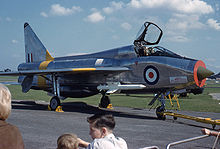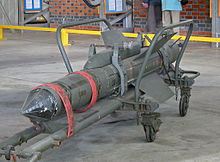- De Havilland Firestreak
-
Firestreak 
Type air-to-air Place of origin United Kingdom Service history In service 1957–1988 Used by United Kingdom, Kuwait, Saudi Arabia. Production history Designed 1951 Specifications Weight 136 kg (300 lb) Length 3.19 m (10 ft 5.5 in) Diameter 0.223 m (8.75 in) Warhead 22.7 kg (50 lb) annular blast fragmentation Detonation
mechanismproximity infrared Engine Magpie solid fuel motor Wingspan 0.75 m (29.4 in) Operational
range4 miles (6.4 km) Speed Mach 3 Guidance
systemrear-aspect infrared Steering
systemcontrol surface Launch
platformfixed-wing aircraft The de Havilland Firestreak is a British first-generation, passive infrared homing air-to-air missile. It was developed by de Havilland (later Hawker Siddeley) in the early 1950s and was the first such weapon to enter active service with the Royal Air Force and Fleet Air Arm, equipping the English Electric Lightning, de Havilland Sea Vixen and Gloster Javelin. It was a rear-aspect, fire and forget pursuit weapon, with a field of attack of 20 degrees either side of the target[1] and was partially replaced in service by a developed variant, the Hawker Siddeley Red Top.
Contents
Development
Firestreak was the result of a series of projects begun with the OR.1056 Red Hawk missile. When this proved too ambitious for the then state of the art, a lower performance specification was released in 1951 as OR.1117, and given the Ministry of Supply rainbow codename Blue Jay.[1]
Blue Jay developed as a fairly conventional-looking missile with cropped delta wings mounted just rear of the midpoint and small rectangular control surfaces in tandem towards the rear. Internally, things were considerably more complex. The rear-mounted controls were operated by nose-mounted actuators via long pushrods. The actuators were powered by compressed air from bottles at the rear. The lead-tellurium (PbTe) IR seeker was mounted under an eight-faceted conical arsenic trisulphide "pencil" nose and was cooled to -180°C (-292°F) by anhydrous ammonia to improve the signal to noise ratio. The unusual faceted nose was chosen when a more conventional hemispherical nose proved prone to ice accretion.[2] There were two rows of triangular windows in bands around the forward fuselage, behind which sat the optical proximity fuzes for the warhead. The warhead was at the rear of the missile, wrapped around the exhaust of the Magpie rocket.
Service
The first airborne launch of Blue Jay took place in 1955 from a de Havilland Venom, the target drone - a Fairey Firefly - being destroyed.[2] Blue Jay Mk.1 entered service in 1957 with the RAF, where it was named Firestreak. Firestreak was deployed by the Royal Navy and the RAF in August 1958;[3] it was the first effective British air-to-air missile.[3]
For launch, the missile seeker was slaved to the launch aircraft's radar (Ferranti AIRPASS in the Lightning and GEC AI.18 in the Sea Vixen) until lock was achieved and the weapons was launched, leaving the interceptor free to acquire another target.[4] A downside was that the missile was highly toxic (probably due to the Magpie rocket motor) and RAF armourers had to wear some form of CRBN protection to safely mount the missile onto an aircraft.[citation needed] "Unlike modern [1990s] missiles, ... Firestreak could only be fired outside cloud, and in winter, skies were rarely clear over the UK."[5]
Improvements
Two Firestreak variants were studied but not adopted: the Mk.2 with a new motor, and the Mk.3 with increased wingspan and reduced top speed, for use with rocket-powered interceptors such as the Saunders-Roe SR.177 and Avro 720, according to Specification F.124T.[4]
Firestreak was developed into Blue Jay Mk.4 (later renamed Blue Vesta), again intended for use by rocket-powered interceptors against high-speed Soviet bombers. In the end, Specification F.124T was cancelled but Blue Jay Mk.4 development continued. Blue Jay Mk.4 ultimately entered service as the Red Top in 1964.[3] Despite Red Top being intended to replace Firestreak, Firestreak remained in limited service until the final retirement of the Lightning in 1988; the carriage of these missiles improved the aircraft's aerodynamics.
Red Top was faster and had a longer range than Firestreak,[3] and "was capable of all aspect homing against super-sonic targets."[3] An important difference between Firestreak and Red Top was the electronics technology used. Firestreak electronics used thermionic valves, which were "wired in" to the control / guidance electronics and required a system of cooling pipes to remove the heat generated by the valve filaments. For this reason, the Firestreak missile on ground test was cooled by Arcton and in flight by ammonia pumped through the missile from the parent aircraft. The Red Top electronics were constructed using transistors which were heated instead.
Operators
References
Notes
- ^ a b Gibson 2007, p. 33
- ^ a b Gibson 2007, p. 34
- ^ a b c d e Boyne, Walter J, Air Warfare: an International Encyclopedia, Volume 1, pub ABC-CLIO Inc, 2002, ISBN 1-57607-345-9 p267.
- ^ a b Gibson 2007, p. 35
- ^ Black, Ian, The Last of the Lightnings, pub PSL, 1996, ISBN 1-85260-541-3, p141.
Bibliography
- Gibson, Chris; Buttler, Tony (2007). British Secret Projects: Hypersonics, Ramjets and Missiles. Midland Publishing. pp. 33–35. ISBN 978-1857802580.
External links
Guided missiles of the United Kingdom Air-to-air Air-to-surface Surface-to-air Bloodhound · Blowpipe · Javelin · Rapier · Sea Cat · Sea Dart · Sea Slug · Sea Viper · Sea Wolf · Starburst · Starstreak · Tigercat · Thunderbird
Surface-to-surface Nuclear Blue Steel · Blue Streak · Blue Water · Green Cheese
1 Anglo-French 2 Anglo-Australian Lists relating to aviation General Aircraft (manufacturers) · Aircraft engines (manufacturers) · Airlines (defunct) · Airports · Civil authorities · Museums · Registration prefixes · Rotorcraft (manufacturers) · TimelineMilitary Accidents/incidents Records Categories:- Cold War air-to-air missiles of the United Kingdom
Wikimedia Foundation. 2010.


